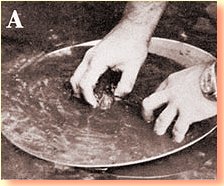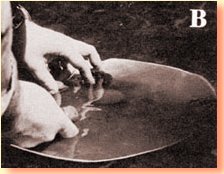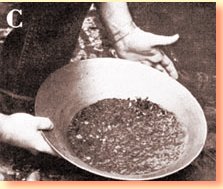Gold Panning
Gold Panning
Panning is a very simple process, and with a little practice, anyone can pan efficiently. Panning is basically the shaking of heavy particles to the bottom, then washing off the lighter particles from the top.
A - WASHING OFF LARGER ROCKS AND MOSS

A1.Fill your pan 3/4 full of sand and gravel. Put the pan deep enough so that it is just under the surface of the water. Now give the pan several good shakes back and forth and from side to side. A2.from the hard shaking motion to a gentle circular motion, so that the material starts rotating in a circle.
A3.This process will cause most of the dirt to dissolve and wash out of the pan. If roots, moss or lumps of clay occur,break up these lumps by hand while still submerged in the pan.
A4.Scoop out the larger rocks and discard them, after first making sure that they are clean.
A5.Repeat processes one and two to get the smaller rocks to the surface, thereby allowing the heavier material to work its way to the bottom.
B - WASHING OF LIGHTER SAND AND GRAVEL

B1.Hold the pan just below the water and tilt away from the body. Begin rotating the material from side to side, with a slight forward, tossing motion. This must be done carefully, so as not to wash out any of the gold, but with sufficient force to slough the surface and lighter gravel out over the lip of the pan.
B2.Level the pan occassionally, and shake it back and forth and from side to side. This will allow the gold to settle on the bottom, while the lighter material comes to the surface.
B3.Repeat processes 1 and 2 of step B, increasing the slope of the pan gradually as the material decreases, until only about two cups of heavier material remain in your pan. This material is composed of black sand, concentrates and-hopefully-gold!
C - WASHING OF BLACK SANDS AND CONCENTRATES

C1.At this point, lift the pan completely out of the creek, retaining about an inch of water in the pan. Hold the pan in a horizontal position and swirl the mixture slowly in a circular motion. This spreads the material evenly over the bottom of the pan, allowing you to check for nuggets and particles of gold that can be easily picked up by hand or with tweezers.
C2.Once you have done this, submerge the pan again andrepeat processes 1 and 2 of Step B for final concentration. Once you've mastered gold panning, you should be able to continue this process until only four or five tablespoons of concentrates are left in your pan. Check the residue for any flakes or grains that can be picked out by tweezers.
Now, what do you do with all that gold you've found...
The nuggets, grains or flakes you've recovered should be put in a screw top container. Then dump the remainder of your dirt and gravel into a large bucket for later processing.
When using a gold pan, ignore the minute specks of glittering yellow known as "flour" gold. You're only wasting time and effort. One small piece of gold no larger than a grain of rice contains more gold, by weight, than all the flour gold you can accumulate in a full day's hard panning. However, flour gold is a good indication of gold in the area. It also indicates that it has travelled a considerable distance from its original source. Therefore, when you find flour, or fine, gold, move farther upstream and try again. Remember: the gold particles will continually increase in size as you approach their source.
Adapted from: Gold Panner's Manual. Garnet Basque.
Langley, B.C.: Stagecoach Pub. (1976). Pub.'s address: P.O.
Box 3399 Langley, B.C. V3A 4R7



|
Last updated March 31, 1999 |
